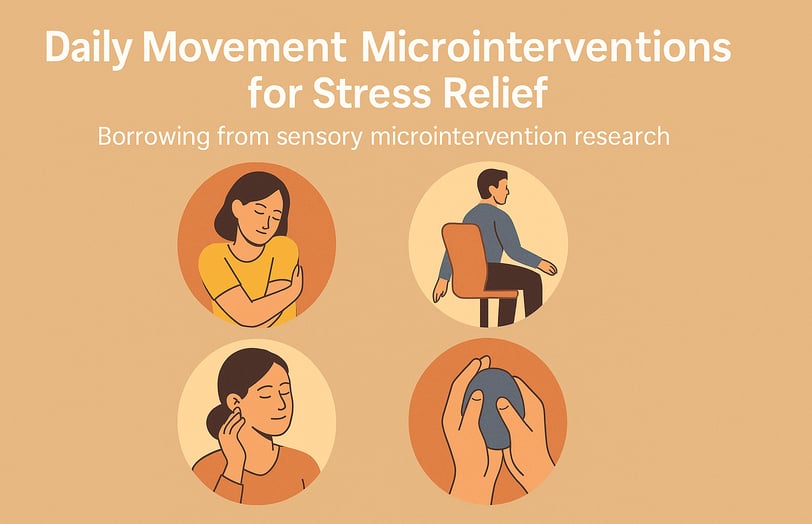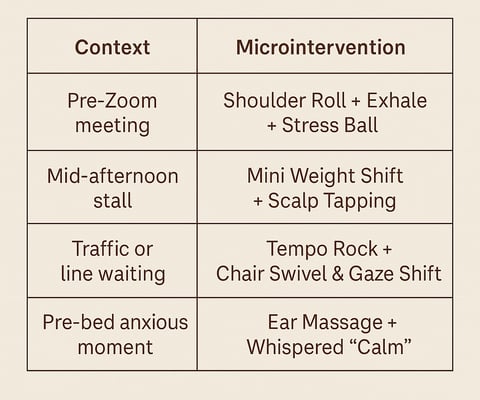Microinterventions for Stress Relief: Quick Daily Habits That Reset Your Nervous System
Discover how 30-second movement microinterventions can reduce stress, regulate your nervous system, and boost resilience—anywhere, anytime. Backed by neuroscience and real studies.
Ignacio Fernandez
6/17/20255 min read


Daily Movement Microinterventions for Stress Relief
Borrowing from sensory microintervention research
Most stress-relief routines—long yoga, weekend walks, meditation apps—require time and space you often don’t have. Enter movement microinterventions: discreet, 30–60 second sensory-motor resets you can do anywhere. Backed by science, these micro-moves tap tactile, proprioceptive, vestibular, and somatic systems to instantly dial down tension. And yes—they’re measurable: lower cortisol, steadier heart rate, sharper focus.
Let’s break it down: what these moves are, why they work, how to do them, and expert-backed sources to show it's real.
What Are Movement Microinterventions?
Movement microinterventions are quick, deliberate actions that engage sensory systems to shift your nervous system’s state. Think of them as mental and physical nano-breaks: easy to integrate, scientifically validated, and effective without disrupting your day.
A key study from UCL, 2025 titled “Sensory‑driven microinterventions for improved health and wellbeing”, found that simple tactile or movement cues could meaningfully reduce cortisol and heart rate. That’s powerful.
The Neuroscience Behind the Reset
Tactile Soothing & Oxytocin
A 2014 review in Frontiers in Psychology, “Self‑soothing behaviors with particular reference to oxytocin release”, explains how light self-touch—like a 30-second embrace—releases oxytocin and deactivates stress pathways.
Proprioceptive Grounding
Shifting weight, pressing your hands against surfaces, or using light resistive tools cues your brain into sensing your body and moment. That breaks stress spirals and boosts embodied awareness.
Vestibular Regulation
Gentle rocking or swaying activates your inner-ear balance system, known to dampen arousal. Occupational therapists use the principle daily for sensory regulation.
Midline Crossing for Brain Integration
Crossing one arm over your chest activates both brain hemispheres, improving emotion control and resilience via interhemispheric connectivity. Tiny but mighty. These moves aren’t fluff—they trigger real neurophysiological changes that help you reset instantly.
8 Microinterventions You Can Use Anywhere
Each move is under one minute—no outfit change, no room required.
Cross‑Midline Self‑Hug
Cross one arm over your chest, hold for 30 seconds, then switch. Loosens tension and calms nervous signals.Shoulder Roll + Exhale
Shoulders roll forward during inhale, backward during exhale, repeated 3‑5 times. It opens your chest and signals safety.Mini Weight Shift
Shift your weight laterally or forward/back subtly for five reps. Regrounding in motion recalibrates the system.Scalp Tapping
Lightly tap random scalp spots for 30 seconds. Disrupts mental loops and stimulates calming touch receptors.While doing this, use the Tactile Scalp Ring Massager for effortless access at your desk.
Tempo Rock
Stand or sit and rock heel-to-toe gently. Vestibular input like this soothes the nervous system.Ear Massage + Whispered “Calm”
Massage earlobes or mastoid area, whisper “calm” with each exhale. A combo of touch and verbal anchoring.Add depth with a Velvet Headband Ear‑Massager for enhanced sensation.
Chair Swivel & Gaze Shift
Slight torso swivel while glancing left-right. Engages balance and visual reference for quick cognitive resets.Shoulder‑Squeeze Release
Press shoulders together and lift for 5 seconds, then exhale and release. The physical release signals your body to let go.Hold the Self‑Assist Portable Stress Ball while doing this to enhance proprioceptive awareness.
When and where to reset?
Building a Sustainable Micro Habit
Pick one move—start with shoulder rolls.
Anchor it—after checking your email, before coffee.
Log it—a checkmark works.
Add a second move like scalp tapping after a week.
Reflect weekly—track calm, focus, posture.
Why It Works: Evidence Recap
Cortisol & heart rate dips proven in UCL’s 2025 study
Self-touch and oxytocin release explained in 2014 review
Vestibular and proprioceptive regulation validated in occupational therapy
Midline crossing and emotional integration shown in neuroscience research
The Brain-Body Bridge: Why These Small Moves Work So Fast
Your nervous system thrives on patterns. When you're stuck in fight-or-flight mode, those patterns become rigid — shallow breathing, tense muscles, hyperfocus on threats. Movement microinterventions snap you out of those loops by providing your brain with novel sensory input.
For example, proprioceptive loading — like pressing your feet into the ground or holding light resistance — increases sensory afferent signals to your somatosensory cortex. This helps shift the brain out of survival mode and into a regulated, grounded state. Similarly, vestibular motion like rocking or rotating helps reset arousal by activating balance circuits closely linked with the cerebellum, a region known for motor coordination and emotional processing.
More than Just “Mindfulness with Movement”
While movement microinterventions can feel meditative, they're different from typical mindfulness practices. They're not about long focus or silence — they're about rapid sensory disruption. The body sends a clear signal that says, “We’re okay now.” That somatic safety is what allows the brain to recalibrate.
Deeper Dive Into Each Move
1.Cross-Midline Self-Hug
Neurologically, crossing the body’s midline requires both hemispheres to coordinate — boosting interhemispheric communication. This can improve not just calmness, but also cognitive switching and task flexibility.
2.Shoulder Roll + Exhale
This isn’t just postural — it resets vagal tone. Rolling the shoulders while breathing deeply stimulates the vagus nerve, which interfaces directly with your parasympathetic system.
3.Mini Weight Shift
Every time you shift weight left-to-right, you’re engaging spinal stabilizers, the cerebellum, and peripheral mechanoreceptors. Try it while standing on a StrongTek Professional Balance Board for enhanced feedback.
4.Scalp Tapping
There’s evidence that cranial nerve input from light touch can influence frontal cortex activity. It’s a simple way to wake up calming neural pathways.
5.Tempo Rock
Slow rocking activates the same vestibular circuits used in sensory swings for therapy. It’s especially powerful when done barefoot or eyes closed.
6.Ear Massage + Whispered Calm
Stimulates the auricular branch of the vagus nerve, which has been studied for its effects on anxiety and relaxation.
7.Chair Swivel & Gaze Shift
When you shift your gaze left to right, you activate orientation pathways in the midbrain and frontal eye fields. It promotes calm and refocus.
8.Shoulder-Squeeze Release
By intentionally squeezing and releasing, you help the brain distinguish between high and low muscle tone. Do this while gripping a TheraBand CLX Resistance Band for added control.
Real-World Use Cases: How High Performers Apply It
Emergency responders use short vestibular resets between intense calls.
Athletes in recovery use micro-movements to rebuild sensorimotor trust.
Executives use chair-based shifts mid-meeting to break tension.
Students self-regulate during exams with subtle sensory tools.
These aren’t just theories—they’re in-field practices.
Rhythm + Microintervention = Next-Level Results
To amplify these effects, sync them with rhythm or breath:
Shoulder rolls to a 4-second inhale, 6-second exhale.
Use a metronome app during balance work.
Pair microinterventions with 10-step walking meditations.
This is how you save better "defaults" into your nervous system.
Bonus: Designing a Daily Flow with Microinterventions
Morning Primer: Tempo rock + ear massage at bedside — start calm.
Pre-Work Anchor: Shoulder rolls + scalp tap before emails.
Midday Reset: Weight shifts + balance board grounding.
Evening Decompression: Chair swivel + whispered breath cues.
Pre-Sleep Wind Down: Cross-hug + nasal breathing + ear massage.
Total time? Less than five minutes. Long-term value? Massive.
Final Takeaway: This is Nervous System Fitness
Stress doesn’t need hours to unravel. Your nervous system adapts quickly—you just have to give it a chance. Every micro-move you take is like laying neural tile for future calm. Whether you’re recovering from a tough day or looking for an edge, movement microinterventions are accessible, evidence-based, and worth practicing. This isn’t wellness fluff. This is resilience, built in motion.
So whether you're managing daily anxiety, looking for an edge in performance, or simply trying to stay sane in a chaotic world, remember this: your body is always available as a tool. These movement microinterventions aren’t just stress hacks — they’re real, trainable access points to balance. Start now, go small, and let your nervous system do the rest.
Studies & Direct Links


FITNESS
Nutrition
WellnesS
info@movebetterco.com
© 2025. All rights reserved | Privacy Policy | Terms & Conditions